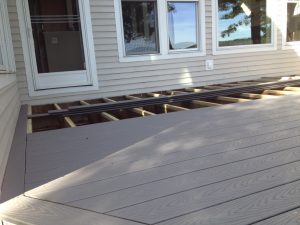The Pros and Cons of Composite Decking and Installation Considerations
By Mark J. Donovan
|
|
Composite decking materials have come a long way since their introduction. Gone are the days when mold and mildew growth became imbedded in between the plastic and wood fibrous materials. Composite decking manufacturers have also addressed much of the crumbling, cracking, and fading issues that were so prevalent with the early composite decking materials.
Composite decking conceptually is a wonderfully green building product due to the fact that it can, and often is, manufactured from recycled plastic and wood products. |
Composite decking boards are also extremely stable compared to wood decking material. With composite decking, expansion and contraction, as well as twisting, curving, and cupping are minimal or non-existent issues altogether.
| Another major advantage of composite decking is that it can be worked with using standard building tools, include skill saws. The only recommendation is to use a higher tooth count blade when cutting the material to ensure cleaner cuts. Also, like wood decking materials, many composite decking cuts can be straight or curved. You can even use a router to bevel or chamfer the edges.
However, there are some types of composite decking materials that may not be suited for this so ask about whether or not the specific type of composite decking material you’re considering can be beveled or chamfered if your plans include this. |
 |
Also, with some types of composite decking material small air bubbles in the composite decking can be exposed when you cut the boards leaving it a bit unsightly.
About the only real complaint with composite decking today is that it is just still so expensive compared to many wood decking materials. In some ways the cost is justifiable as it involves manufacturing, versus harvesting, and it offers so many advantages over wood decking materials. But on the other hand, it is made from recycled materials so you’d think its raw material costs would be low.
Also, if you use hollowed edge composite decking planks you’ll need to address the exposed ends, either by capping the ends or using a skirt around the periphery of the decking surface.
Finally, when it comes to fastening composite decking material to the deck frame you can use either deck nails or screws, just as long as their non-corrosive, e.g. galvanized or stainless steel. Deck screws, however, are typically more recommended. Also, when using screws it is highly recommended to countersink the screws a little bit below the adjacent grade of the deck plank surface.
For help on building a deck, see HomeAdditionPlus.com’s Deck Installation Bid Sheet. The Deck Installation Bid Sheet will teach your how to hire the right deck contractor, and help to ensure that your deck project is completed on time and budget.
Related Information
- How to Install a Composite Deck Railing System Video
- Composite Deck Railing Installation Tips
- Composite Decking Product Manufacturing Choices
Additional Deck Building and Design Resources
 |
 |
Get Free Deck Building Price Quotes with No Obligation!
Fill out our 3-5 minute quick and easy form, and receive a free price quote on decks from one of our pre-screened and licensed deck contractors. This process is free and there is no obligation to continue once you receive your decks price estimate.

